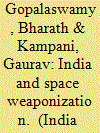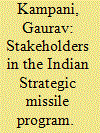| Srl | Item |
| 1 |
ID:
130002


|
|
|
|
|
| Publication |
2014.
|
| Summary/Abstract |
Since China tested a Kinetic-Energy Anti-Satellite (KE-ASAT) weapon in 2007, evidence has surfaced that India may have initiated a similar program. This article makes an anticipatory policy intervention against the development of KE-ASAT weapons. It presents data to show that space debris, and not KE-ASAT weapons, pose the highest risk for the safe operation of Indian satellites. It models a KE-ASAT weapons exchange between India and China in three different scenarios to demonstrate that use of such weapons even on a limited scale would produce an exponential increase in space debris. The latter would threaten the safe operation of satellites for all countries concerned. These data suggest that the concept of deterrence as understood in conventional and nuclear spheres is not easily transportable to the domain of space weapons, which threaten the physical destruction of satellites. If weaponization of space becomes inevitable, policy makers would be better off investing in weapons that disable but do not physically destroy satellites.
|
|
|
|
|
|
|
|
|
|
|
|
|
|
|
|
| 2 |
ID:
131113


|
|
|
|
|
| Publication |
2014.
|
| Summary/Abstract |
In the late 1980s and early 1990s, many academics, think tank analysts, journalists, and government officials came to perceive India as a de facto nuclear weapons power. The consensus among U.S. policymakers was that normative, rather than technical or organizational hurdles, prevented India from transforming its latent nuclear capability into an operational one. New evidence shows, however, that India lacked technical means to deliver nuclear weapons reliably and safely until 1994-95. Further, until the outbreak of the Kargil War in the summer of 1999, political leaders refrained from embedding the weapons within organizational and procedural routines that would have rendered them operational in the military sense of the term. These deficiencies can be traced to a regime of secrecy that prevented information sharing and coordination among the relevant actors. This secrecy stemmed from risk aversion among Indian decisionmakers, who feared international pressures for nuclear rollback, particularly from the United States.
|
|
|
|
|
|
|
|
|
|
|
|
|
|
|
|
| 3 |
ID:
023511


|
|
|
|
|
| Publication |
Fall/winter 2002.
|
| Description |
107-116
|
|
|
|
|
|
|
|
|
|
|
|
|
|
|
|
| 4 |
ID:
057402


|
|
|